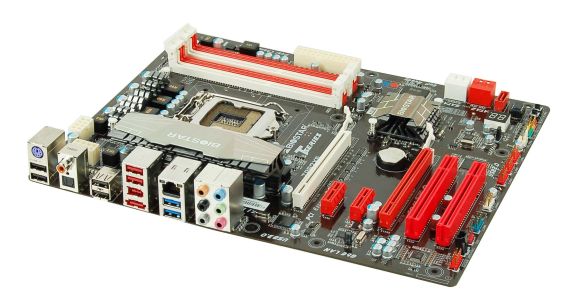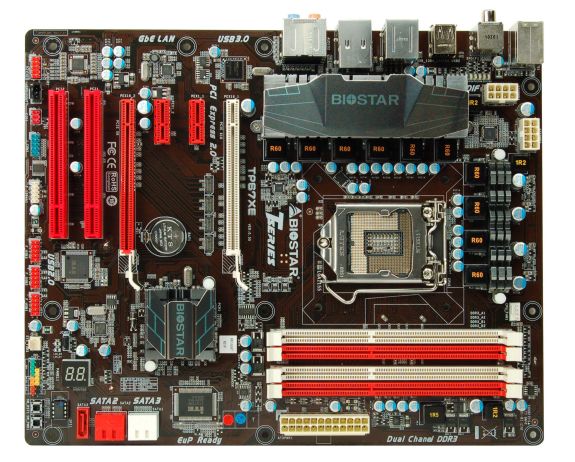A Quick Glimpse of the Biostar TP67XE and TH67XE
by Ian Cutress on September 29, 2010 9:44 AM EST- Posted in
- Biostar
- Motherboards
- News
The first thing that comes to mind when looking at the images of the Biostar TP67XE board is one of space. The motherboard is seemingly devoid of a lot of clutter around the PCI slots.
Click to enlarge
With regard to the PCI slots, we often criticize Biostar of getting the configuration wrong - 4 PCIe followed by 2 PCI, for example on their TA890FXE. This time, they’ve made an effort - a PCIe x16 (x8 in CrossFireX), followed by two PCIe x1, then a PCIe x8, and two PCI. Thus if you fill both PCIe slots with dual slot graphics cards, there’s still a PCIe and a PCI available. It’s a step in the right direction, sure, but there’s a better layout we would prefer (switch the first two, and also the PCIe x8 with the next PCI), meaning only the PCI card will have to deal with any direct heat from a dual GPU setup. Aside from this, the livery is the distinct white and orange we’ve come to expect from Biostar. Just don’t go mixing up the second PCIe with those PCI - which are both orange. No matter how hard you try and jam a card into the wrong slot, something will end up breaking.
One thing of note on this board is the dual 8-pin 12V connectors near the socket. In the past, only high end boards designed for extreme overclocking have two of these, to enable more juice to the processor. Could Biostar be wanting to tackle the high-end overclocking giants of ASUS, Gigabyte, MSI and EVGA? Biostar may need to introduce a Dual-BIOS type system as a step in the right direction, then.
Given that all the Sandy Bridge processors currently announced will have integrated graphics, you may remember from our Sandy Bridge overview that the P67 boards will lose integrated graphics capability in order to fund 2 x8 PCIe lanes. That being said, if this is truly a motherboard aimed at the high end, almost everyone in that segment will be using at least one discrete GPU.
The rest of the board is what we have come to expect from the myriad of Sandy Bridge paraphernalia - two SATA 6Gb/s connectors with three SATA 3Gb/s, USB 3.0 supplied via the NEC controller, gigabit ethernet, eight USB 2.0 connectors in the back panel, another six available through onboard headers, dual channel DDR3, S/PDIF audio out, a sole PS/2 connector, firewire, an e-SATA connector, and a COM header. In keeping with the overclockable theme, a two-digit error code display is also provided to debug and boot issues, as well as simple power and reset switches. However, against that theme, is the sole non-CPU fan connector sitting at the bottom of the board. Keeping your RAM cool will thus require decent airflow, or fans connected directly to the power supply.
We don’t expect this board to set the world on fire compared to the high-end motherboards of other competitors, so in order to sell, Biostar will have to price this board very aggressively.
Click to enlarge












27 Comments
View All Comments
Pneumothorax - Wednesday, September 29, 2010 - link
As far as I'm concerned this is a 1156 board with 3rd party USB thrown in. Intel could've easily made SB backwards compatible without a performance hitMathieu Bourgie - Wednesday, September 29, 2010 - link
Trust me, you're far from the only one who feels that way. Myself and a lot of people who I talk to feel like Intel are robbing whoever bought a 1156 board.Was this new socket/chipset made necessary by the new IGP and/or new CPU? I don't know. What I know though, is that a lot of people would have gladly upgraded their 1156 PC if SB was backward compatible and that quite a few of them don't want/need a new motherboard already.
Then again, I have a feeling that this was done as a business decision by Intel, simply to sell more of their chipsets and to make their motherboard partners happy to sell more motherboards.
My 2 cents.
icrf - Wednesday, September 29, 2010 - link
http://www.realworldtech.com/page.cfm?ArticleID=RW...
Wieland - Wednesday, September 29, 2010 - link
That isn't something most of us necessarily wanted to be changed or something that (from what I understand) necessarily had to to be changed.SteelCity1981 - Tuesday, October 5, 2010 - link
Still with that said the Sandy Bridge Cpu's could have been backwards compatible with the Intel 5 series motherboards. Nothing in that whole artical indicated that Sandy Bridge couldn't be ran on an Intel 5 series socket. All it was displaying is the internal cpu changes of Sandy Bridge itself.arubino99 - Monday, January 10, 2011 - link
Sorry, but you are HIGHLY mistaken.The current SB archtecture will NOT work with current MBs, as the linked article states clearly.
You'd also be upset if Intel released a backwards compatible chip that offered minimal upgrades. "oh, it's another Intel chip I don't need for marginal performance upgrade"
Let's face, innovation requires a different line of thinking. There's only so far you could push the 775 architecture, and there's only so far you can push the 1156. Have you seen Anand's very own OC of the 1155 chips? 5 Ghz... on AIR.
If you had read this and looked at HOW DIFFERENT these chips actually are (other than herp derp pin count), you wouldn't be making comments like this.
nbjknk - Thursday, November 25, 2010 - link
Dear customers, thank you for your support of our company.
Here, there's good news to tell you: The company recently
launched a number of new fashion items! ! Fashionable
and welcome everyone to come buy. If necessary, please$$$$$$$$$$__$$$_$$$$$$$$$$$
http://www.vipshops.org
$$_____$$$_$$$_________$$$
$$$_____$$$_$$$______ $$$
$$$ ____$$$_ $$$_____ $$$
$$$$$$$$$$__$$$____$$$
$$$_____$$$_$$$___$$$
$$$_____$$$_$$$__$$$
$$$$$$$$$$$_$$$_$$$
$$$$$$$$$$__$$$_$$$$$$$$$$$$ !::!
http://www.vipshops.org
Thursday, 21 October 2010 at 9:48 PM
Mathieu Bourgie - Wednesday, September 29, 2010 - link
Second paragraph, last word:" No matter how hard you try and jam a card into the wrong slot, something will end up braking."
I'm pretty sure that you meant "breaking" there.
Good article otherwise, thanks for the preview. Looks like Biostar is coming out with more interesting products.
IanCutress - Wednesday, September 29, 2010 - link
Thanks Mathieu, correction made!Ian
vol7ron - Thursday, September 30, 2010 - link
" No matter how hard you try and jam a card into the wrong slot, something will end up breaking."...that's what she said...
Seriously though, doesn't that sentence sound wrong? Wouldn't it be something like... "no matter how delicately you try to place a card into the wrong slot, something will end up breaking?"
-----------------------------------
Good article, the USBs on the board look sexy.